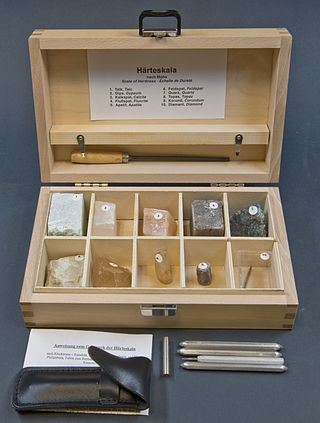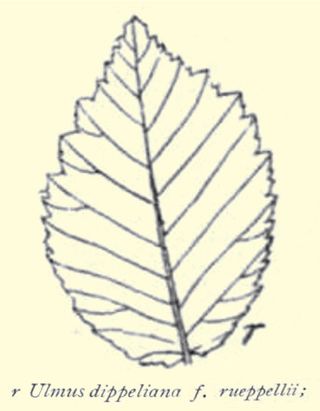
The Mohs scale of mineral hardness is a qualitative ordinal scale, from 1 to 10, characterizing scratch resistance of minerals through the ability of harder material to scratch softer material.

Pieter Bleeker was a Dutch medical doctor, ichthyologist, and herpetologist. He was famous for the Atlas Ichthyologique des Indes Orientales Néêrlandaises, his monumental work on the fishes of East Asia published between 1862 and 1877.

Naturalis Biodiversity Center is a national museum of natural history and a research center on biodiversity in Leiden, Netherlands. It was named the European Museum of the Year 2021. Although its current name and organization are relatively recent, the history of Naturalis can be traced back to the early 1800s. Its collection includes approximately 42 million specimens, making it one of the largest natural history collections in the world.

The hybrid elm cultivar Ulmus 'Den Haag' is a Dutch development derived from a chance crossing of the Siberian Elm cultivar Ulmus pumila 'Pinnato-ramosa' and the Belgian Elm Ulmus × hollandica 'Belgica'. S. G. A. Doorenbos (1891-1980), Director of Public Parks in The Hague, finding that seeds he had sown in 1936 from the Zuiderpark 'Pinnato-ramosa' had hybridized with the local 'Belgica', selected six for trials. The best was cloned and grafted on 'Belgica' rootstock as 'Den Haag'; it was planted first in that city, then released to nurseries elsewhere in the Netherlands. The other five were also planted in The Hague.
The elm cultivar Ulmus 'Monstrosa' [: "monstrous", "strange"], a shrub-elm with fasciated branching, is believed to have originated in France, where it was first listed by Lavallée in Arboretum Segrezianum (1877) as a form of Field Elm, Ulmus campestris var. monstrosa, but without description. Though its long slender 2 cm petiole is not a feature of wych elm U. glabraHuds., and is even less likely in a shrub form of this species, the wych-cultivar error arose early, perhaps because the Späth nursery of Berlin, using Ulmus montana both for some Ulmus × hollandica cultivars and for wych varieties, listed it c.1890 as Ulmus montana monstrosa. Hartwig in Illustrirtes Gehölzbuch (1892) followed with Ulmus scabra monstrosa, an error repeated by Krüssman (1962) and by Green (1964), with their U. glabraHuds. 'Monstrosa'.

Ulmus minor 'Rueppellii' is a Field Elm cultivar said to have been introduced to Europe from Tashkent by the Späth nursery, Berlin. Noted in 1881 as a 'new elm', it was listed in Späth Catalogue 73, p. 124, 1888–89, and in subsequent catalogues, as Ulmus campestris Rueppelli, and later by Krüssmann as a cultivar.
The elm cultivar Ulmus 'Rubra' was reputedly cloned from a tree found by Vilmorin in a wood near Verrières-le-Buisson in the 1830s. It was listed in the 1869 Catalogue of Simon-Louis, Metz, France, as Ulmus campestris rubra, and by Planchon in de Candolle's Prodromus Systematis Naturalis Regni Vegetabilis (1873) as Ulmus libero-rubra: 'Orme à liber rouge' [:elm with red inner bark]. Elwes and Henry (1913) and Bean (1936) listed it as Ulmus montana [:U. glabraHuds.] var. libro-rubro, the former stating that the tree appeared "identical" to Simon-Louis's Ulmus campestris rubra. A specimen in the Zuiderpark, The Hague, was identified in 1940 as a wych elm cultivar, U. glabraHuds.libero rubro.
The Elm cultivar Ulmus 'Tiliaefolia' was first mentioned by Host in Flora Austriaca (1827), as Ulmus tiliaefolia [:linden-leaved]. The Späth nursery of Berlin distributed a 'Tiliaefolia' from the late 19th century to the 1930s as neither an U. montana hybrid nor a field elm cultivar, but simply as Ulmus tiliaefolia, suggesting uncertainty about its status. Herbarium specimens appear to show two clones, one smaller-leaved and classified as a field elm cultivar, the other larger-leaved.

The elm cultivar Ulmus × hollandica 'Haarlemensis', said to have been grown from seed c.1880 from a hybrid parent tree, was first listed by Springer as U. campestris haarlemensis in 1912.

The Field Elm cultivar Ulmus minor 'Umbraculifera Gracilis' was obtained as a sport of 'Umbraculifera' by the Späth nursery of Berlin c.1897. It was marketed by the Späth nursery in the early 20th century, and by the Hesse Nursery of Weener, Germany, in the 1930s.
The elm cultivar Ulmus 'Lombartsii' is considered "possibly Ulmus × hollandica or Ulmus carpinifolia " by Green (1964). The tree was raised by Lombarts Nurseries at Zundert, Netherlands, circa 1910.
Ulmus × arbusculaE. Wolf [: "bushy" ] is a putative hybrid of Ulmus scabra and Ulmus pumila raised from seed collected from a large wych elm in the St. Petersburg Botanic Garden in 1902. A similar crossing was cloned ('FL025') by the Istituto per la Protezione delle Piante (IPP), Florence, as part of the Italian elm breeding programme circa 2000.

AnimaNaturalis is an international non profit animal rights organization whose mission is to "Establish, promote and protect the rights of all animals in Spain and Latin America. These rights include the right to life, liberty, and not to be tortured stop being considered property." It was founded in March, 2003 by Leonora Esquivel Frías and Francisco Vásquez Neira.

Rutidosis is a genus of Australian annual and perennial herbs in the tribe Gnaphalieae within the family Asteraceae.
Phacellothrix is a genus of flowering plants in the pussy's-toes tribe within the daisy family.

Zoologische Mededelingen was a peer-reviewed open access scientific journal publishing papers and monographs on animal systematics. The publisher was the National Museum of Natural History Naturalis in the Netherlands. The first issue appeared in 1915, as the official journal of Naturalis' predecessor, the Rijks Museum van Natuurlijke Historie. Earlier, the museum published Muséum d'Histoire Naturelle des Pays-Bas and Notes from the Leyden Museum, which mainly covered the fauna of the Netherlands and the former Dutch colonies.

Ulmusaff. 'Plotii', or 'pseudo-Plotii', was the name first used by Melville in the 1940s for elms in England, of various genotypes, that resemble but do not completely match the 'type'-tree, U. minor 'Plotii'. It was taken up again following Dr Max Coleman's findings about Plot Elm (2000) and his paper on British elms (2002).
The hybrid elm Ulmus davidianavar.japonica × U. minor was raised at the Arnold Arboretum before 1924.
Cladochaeta sturtevanti is a species of fruit fly in the family Drosophilidae.










